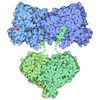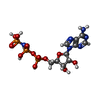+ Open data
Open data
- Basic information
Basic information
| Entry | Database: PDB / ID: 7cgy | ||||||||||||
|---|---|---|---|---|---|---|---|---|---|---|---|---|---|
| Title | Human DMC1 Q244M mutant of the post-synaptic complexes | ||||||||||||
 Components Components | Meiotic recombination protein DMC1/LIM15 homolog | ||||||||||||
 Keywords Keywords | RECOMBINATION / meiotic homologous recombination / DNA repair / ATPase | ||||||||||||
| Function / homology |  Function and homology information Function and homology informationfemale gamete generation / chromosome organization involved in meiotic cell cycle / DNA recombinase assembly / double-strand break repair involved in meiotic recombination / homologous chromosome pairing at meiosis / DNA strand invasion / mitotic recombination / DNA strand exchange activity / lateral element / reciprocal meiotic recombination ...female gamete generation / chromosome organization involved in meiotic cell cycle / DNA recombinase assembly / double-strand break repair involved in meiotic recombination / homologous chromosome pairing at meiosis / DNA strand invasion / mitotic recombination / DNA strand exchange activity / lateral element / reciprocal meiotic recombination / oocyte maturation / ATP-dependent DNA damage sensor activity / male meiosis I / spermatid development / ATP-dependent activity, acting on DNA / ovarian follicle development / condensed nuclear chromosome / meiotic cell cycle / Meiotic recombination / single-stranded DNA binding / site of double-strand break / chromosome / double-stranded DNA binding / spermatogenesis / chromosome, telomeric region / ATP hydrolysis activity / DNA binding / nucleoplasm / ATP binding / identical protein binding / nucleus Similarity search - Function | ||||||||||||
| Biological species |  Homo sapiens (human) Homo sapiens (human) | ||||||||||||
| Method | ELECTRON MICROSCOPY / helical reconstruction / cryo EM / Resolution: 3.2 Å | ||||||||||||
 Authors Authors | Chi, H.Y. / Ho, M.C. / Tsai, M.D. / Luo, S.C. / Yeh, H.Y. | ||||||||||||
| Funding support |  Taiwan, 3items Taiwan, 3items
| ||||||||||||
 Citation Citation |  Journal: Nat Commun / Year: 2021 Journal: Nat Commun / Year: 2021Title: Identification of fidelity-governing factors in human recombinases DMC1 and RAD51 from cryo-EM structures. Authors: Shih-Chi Luo / Hsin-Yi Yeh / Wei-Hsuan Lan / Yi-Min Wu / Cheng-Han Yang / Hao-Yen Chang / Guan-Chin Su / Chia-Yi Lee / Wen-Jin Wu / Hung-Wen Li / Meng-Chiao Ho / Peter Chi / Ming-Daw Tsai /  Abstract: Both high-fidelity and mismatch-tolerant recombination, catalyzed by RAD51 and DMC1 recombinases, respectively, are indispensable for genomic integrity. Here, we use cryo-EM, MD simulation and ...Both high-fidelity and mismatch-tolerant recombination, catalyzed by RAD51 and DMC1 recombinases, respectively, are indispensable for genomic integrity. Here, we use cryo-EM, MD simulation and functional analysis to elucidate the structural basis for the mismatch tolerance of DMC1. Structural analysis of DMC1 presynaptic and postsynaptic complexes suggested that the lineage-specific Loop 1 Gln244 (Met243 in RAD51) may help stabilize DNA backbone, whereas Loop 2 Pro274 and Gly275 (Val273/Asp274 in RAD51) may provide an open "triplet gate" for mismatch tolerance. In support, DMC1-Q244M displayed marked increase in DNA dynamics, leading to unobservable DNA map. MD simulation showed highly dispersive mismatched DNA ensemble in RAD51 but well-converged DNA in DMC1 and RAD51-V273P/D274G. Replacing Loop 1 or Loop 2 residues in DMC1 with RAD51 counterparts enhanced DMC1 fidelity, while reciprocal mutations in RAD51 attenuated its fidelity. Our results show that three Loop 1/Loop 2 residues jointly enact contrasting fidelities of DNA recombinases. | ||||||||||||
| History |
|
- Structure visualization
Structure visualization
| Movie |
 Movie viewer Movie viewer |
|---|---|
| Structure viewer | Molecule:  Molmil Molmil Jmol/JSmol Jmol/JSmol |
- Downloads & links
Downloads & links
- Download
Download
| PDBx/mmCIF format |  7cgy.cif.gz 7cgy.cif.gz | 167.2 KB | Display |  PDBx/mmCIF format PDBx/mmCIF format |
|---|---|---|---|---|
| PDB format |  pdb7cgy.ent.gz pdb7cgy.ent.gz | 133.7 KB | Display |  PDB format PDB format |
| PDBx/mmJSON format |  7cgy.json.gz 7cgy.json.gz | Tree view |  PDBx/mmJSON format PDBx/mmJSON format | |
| Others |  Other downloads Other downloads |
-Validation report
| Summary document |  7cgy_validation.pdf.gz 7cgy_validation.pdf.gz | 1.2 MB | Display |  wwPDB validaton report wwPDB validaton report |
|---|---|---|---|---|
| Full document |  7cgy_full_validation.pdf.gz 7cgy_full_validation.pdf.gz | 1.2 MB | Display | |
| Data in XML |  7cgy_validation.xml.gz 7cgy_validation.xml.gz | 39.5 KB | Display | |
| Data in CIF |  7cgy_validation.cif.gz 7cgy_validation.cif.gz | 55.3 KB | Display | |
| Arichive directory |  https://data.pdbj.org/pub/pdb/validation_reports/cg/7cgy https://data.pdbj.org/pub/pdb/validation_reports/cg/7cgy ftp://data.pdbj.org/pub/pdb/validation_reports/cg/7cgy ftp://data.pdbj.org/pub/pdb/validation_reports/cg/7cgy | HTTPS FTP |
-Related structure data
| Related structure data |  30366MC  7c98C  7c99C  7c9aC  7c9cC M: map data used to model this data C: citing same article ( |
|---|---|
| Similar structure data |
- Links
Links
- Assembly
Assembly
| Deposited unit | 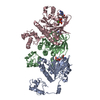
|
|---|---|
| 1 |
|
- Components
Components
| #1: Protein | Mass: 37734.098 Da / Num. of mol.: 3 / Mutation: Q244M Source method: isolated from a genetically manipulated source Source: (gene. exp.)  Homo sapiens (human) / Gene: DMC1, DMC1H, LIM15 / Production host: Homo sapiens (human) / Gene: DMC1, DMC1H, LIM15 / Production host:  #2: Chemical | #3: Chemical | Has ligand of interest | N | |
|---|
-Experimental details
-Experiment
| Experiment | Method: ELECTRON MICROSCOPY |
|---|---|
| EM experiment | Aggregation state: FILAMENT / 3D reconstruction method: helical reconstruction |
- Sample preparation
Sample preparation
| Component |
| ||||||||||||||||||||||||||||
|---|---|---|---|---|---|---|---|---|---|---|---|---|---|---|---|---|---|---|---|---|---|---|---|---|---|---|---|---|---|
| Source (natural) | Organism:  Homo sapiens (human) Homo sapiens (human) | ||||||||||||||||||||||||||||
| Source (recombinant) | Organism:  | ||||||||||||||||||||||||||||
| Buffer solution | pH: 7.5 Details: 25 mM Tris-HCl, pH 7.5, 50 mM KCl and 1 mM dithiothreitol) containing 2 mM AMP-PNP and 5 mM CaCl2 | ||||||||||||||||||||||||||||
| Specimen | Embedding applied: NO / Shadowing applied: NO / Staining applied: NO / Vitrification applied: YES Details: protein sample were applied onto a pre-glow-discharged graphene-oxide coated Quantifoil holey carbon grid (1.2/1.3, 200 mesh) using published protocol | ||||||||||||||||||||||||||||
| Specimen support | Grid type: Quantifoil R1.2/1.3 | ||||||||||||||||||||||||||||
| Vitrification | Instrument: FEI VITROBOT MARK IV / Cryogen name: ETHANE / Humidity: 100 % / Chamber temperature: 295 K Details: The grids were blotted for 1 sec at 22 degree C with 100% relative humidity and plunge-frozen in liquid ethane cooled by liquid nitrogen using a Vitrobot Mark IV (Thermo Fisher). |
- Electron microscopy imaging
Electron microscopy imaging
| Experimental equipment |  Model: Titan Krios / Image courtesy: FEI Company |
|---|---|
| Microscopy | Model: FEI TITAN KRIOS |
| Electron gun | Electron source:  FIELD EMISSION GUN / Accelerating voltage: 300 kV / Illumination mode: FLOOD BEAM FIELD EMISSION GUN / Accelerating voltage: 300 kV / Illumination mode: FLOOD BEAM |
| Electron lens | Mode: BRIGHT FIELD / Nominal magnification: 165000 X / Cs: 2.7 mm / C2 aperture diameter: 70 µm / Alignment procedure: COMA FREE |
| Specimen holder | Cryogen: NITROGEN / Specimen holder model: FEI TITAN KRIOS AUTOGRID HOLDER / Residual tilt: 10 mradians |
| Image recording | Average exposure time: 5 sec. / Electron dose: 50 e/Å2 / Detector mode: COUNTING / Film or detector model: GATAN K2 QUANTUM (4k x 4k) / Num. of grids imaged: 1 |
| EM imaging optics | Energyfilter name: GIF Quantum LS / Energyfilter slit width: 30 eV |
| Image scans | Width: 3838 / Height: 3710 / Movie frames/image: 50 / Used frames/image: 1-50 |
- Processing
Processing
| EM software |
| ||||||||||||||||||||||||||||||||
|---|---|---|---|---|---|---|---|---|---|---|---|---|---|---|---|---|---|---|---|---|---|---|---|---|---|---|---|---|---|---|---|---|---|
| CTF correction | Type: PHASE FLIPPING AND AMPLITUDE CORRECTION | ||||||||||||||||||||||||||||||||
| Helical symmerty | Angular rotation/subunit: 55.93 ° / Axial rise/subunit: 16 Å / Axial symmetry: C1 | ||||||||||||||||||||||||||||||||
| Particle selection | Num. of particles selected: 643100 Details: Filaments were manually picked, and segments were extracted using a box size of 384 pixel and an inter-box distance of ~10% of the box length. | ||||||||||||||||||||||||||||||||
| 3D reconstruction | Resolution: 3.2 Å / Resolution method: FSC 0.143 CUT-OFF / Num. of particles: 232018 / Algorithm: FOURIER SPACE / Num. of class averages: 4 / Symmetry type: HELICAL |
 Movie
Movie Controller
Controller









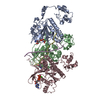

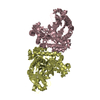

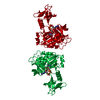

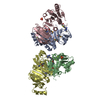

 PDBj
PDBj








